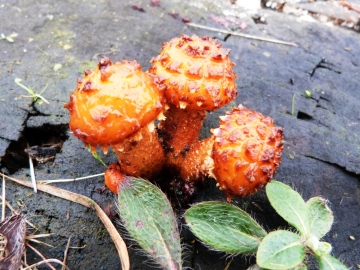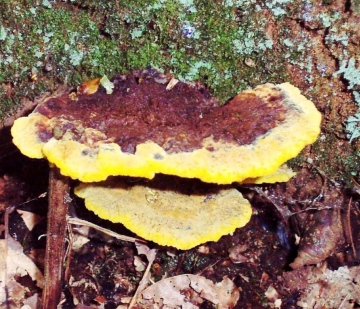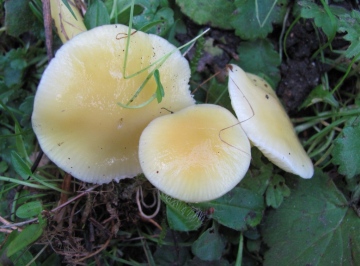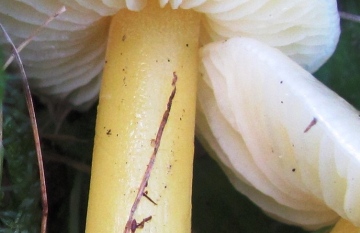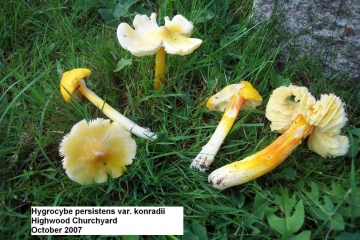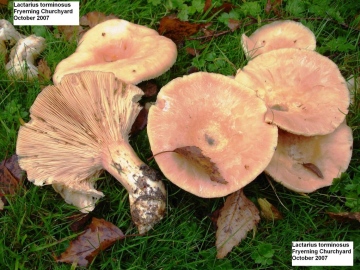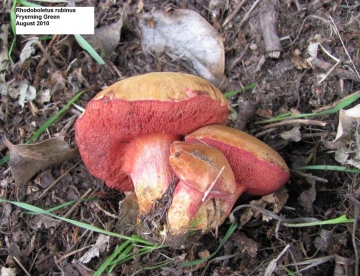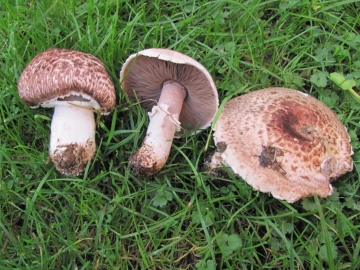At my favourite foraying site - Fryerning Churchyard - the season followed a similar pattern to the above; or at least it did until late October when, in the space of no more than a few days, ten new fungi were added to a churchyard list that now stands at around 275 species. One of them was this Pholiota, growing out of a birch stump. When first found the glutinous cap surface suggested that it might be P.jahnii but unlike most species it was slow to mature and it was not until the Club Waxcap Foray on November 3rd that the caps had opened sufficiently to obtain a spore print. Tony was then able to identify it as P.adiposa which, according to the 'Checklist', is a rare species in Britain but which in Funga Nordica, is treated as being conspecific with the much commoner P. aurivella(us).
The high species total at Fryerning is in large part due to the range of trees found there, several of which support an impressive array of microrrhizal fungi associates. This is particularly true of the Silver Birches and Scots Pines. Unfortunately, many of them seem to be suffering from stress - perhaps related to the string of exceptionally dry summers prior to this year's deluge - and several fine specimens have been lost in the last decade including an impressive Indian Cedar, probably planted in the Edwardian era. Now, one of the two remaining old Yews, which is probably in the region of 350 years old, appears to be succumbing - around one third of the canopy dying during the past two years - while the other sports a magnificent Chicken of the Woods each summer, the presence of which is likely to lead to its eventual demise. Several other trees are also under attack from parasitic fungi. One, a Scots Pine, had three species assaulting one side of it - causing all the branches on that side to fall off - leaving it very lopsided. This year a fourth species joined in - Phaeolus schweinitzii, otherwise known as Dyer's Mazegill. I doubt if the tree is long for this world, the only compensation (for me if not the pine) is that it was another new species for the churchyard!
The Waxcap foray produced 6-7 species at the Churchyard, since when a further three species have appeared but it has still been a poor year. Tony was best pleased with Chelmsford Crematorium, where there were no fewer than 13 species on display this year. There was no sign of the Glutinous Waxcap Hygrocybe glutinipes (pictured below) this autumn, one the churchyard's special species, but a recent visit to nearby Highwood Churchyard did produce a fine display of Persistent Waxcap H. persistens var. konradii. H. glutinipes lives up to its name as both cap and stem literally drip with 'gluten', although a little had worn off on the photographed specimens due to handling.
Two colourful species that have fruited since the Waxcap foray have been Bearded Milkcap Lactarius torminosus, which loses its 'beard' and becomes a beautiful salmon pink colour with age and the equally stunning but much rarer Chalciporus (formerly Rubinoboletus) rubinus, which has appeared annually on nearby Fryerning Green in each of the past three years.
Finally, a species which is both rare and edible, to whit, Agaricus cupreobrunneus. Rare but widespread is how Geoffrey Kibby describes it and it certainly appears to be latter along the seawalls of the South Blackwater and northern banks of the Crouch. It is best told from the closely related A. porphryrocephalus by the larger spores but the latter may also occur as you cannot take a spore print from every specimen you find!



















